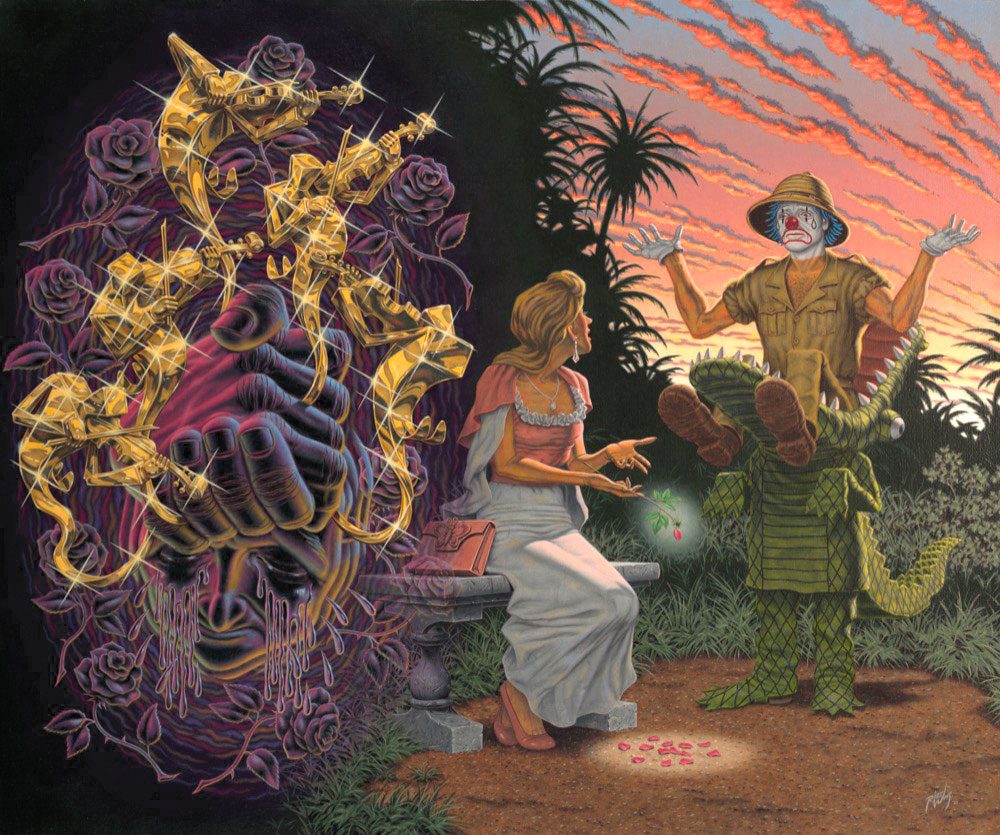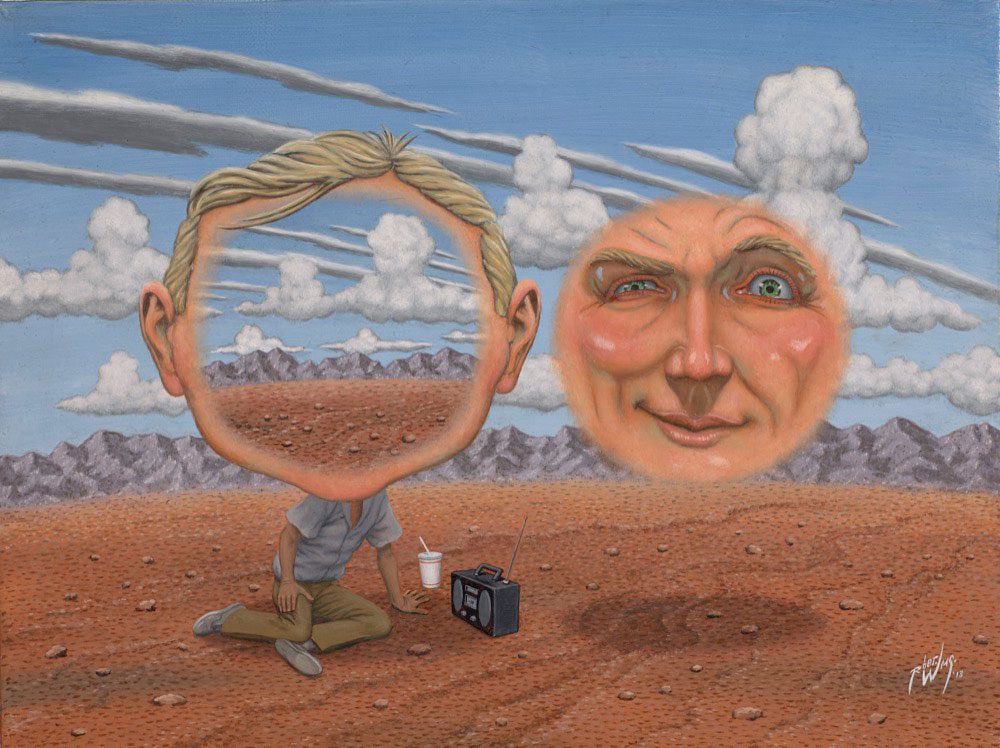Unsophisticated: Robert Williams at the LSU Museum of Art
Dillon Raborn visits Robert Williams’ solo show at the LSU Museum of Art in Baton Rouge. The exhibition features two decades of Williams’ satirical Pop Surrealist paintings.

Robert Williams, The Shattered Rose, 2015. Oil on canvas. Courtesy the artist.
The LSU Museum of Art has taken a risk with its current Robert Williams exhibition “Slang Aesthetics.” The solo show features work spanning roughly the past two decades by Williams, one of the earliest artists working in what has come to be known as Pop Surrealism, a style which eventually birthed the sort of aesthetics now associated with skaters, surfers, punk scenes, and tattoo shops. Williams is also one of the founders of Juxtapoz Magazine, which still prides itself on highlighting the underground, the alternative, and the lowbrow of the art world.
Unabashedly vernacular, “Slang Aesthetics” successfully portrays Williams’ explicit use of art as a satirical tool for exposing social ails and venting criticisms. The majority of the exhibition’s works pay painstaking attention to rendering positively fantastical scenarios in the lineage of artists like Surrealists René Magritte and Dorothea Tanning. This history comes out strongest in Symbiotic Mediocrity, 2007, one of the smallest paintings in the exhibition. The work in oil shows two mauve, nude figures sitting within a plain, grassy landscape, their spines extending like tails and morphing into black power cords plugged into a shared outlet in the ground. The figures’ heads are wood-finished, rabbit-eared televisions staring into each other, the screen within view displaying a greyscale, mirrored rendition of the painting itself, complete with yet another identical television containing, once again, the same mirrored image, creating an imagined infinite regression of CRT gazing. Many such visual tricks are placed throughout Williams’ works, which often merge picturesque scenes and gonzo commentary in worlds that look displaced straight from a pulp magazine.

Robert Williams, Terra Facia, the Exaggerated Persona of a Poetic Location, 2013. Oil on canvas. Courtesy the artist.
Five paintings grouped toward the end of the show mimic a coloring-book aesthetic while adhering to the artist’s trademark whimsicality. Rather than address society at large, these criticize the art world directly. The Consecration of the Accidental Genius, 2011, takes aim at academia, personified as a sunglasses-wearing “Art School” lecture hall in flip-flops. Standing by his discarded beer and bongo drums, the building pours a mixture of gumbo and scrap metal into a pile which takes up most of the canvas. Within this pile, one sees artifacts of a student’s studio: an oversized easel, bony anatomy and geometric prisms for use in still-life composition, and a couple—presumably the parents of the preeminent genius—embracing amidst it all. The vision of the building itself as well as the couple are the only sources of color, in this case glowing pink, as the rest of the canvas relies wholly on cartoonish contours.
This particular work’s attack on the academic art establishment fits within Williams’ general attitude toward “sophistication,” as laid out in the exhibition catalogue. If academia dispenses hegemony via art-world jargon and a set of criteria for what constitutes “good” art, “slang represents freedom from the pretension of sophistication, which leaves the artists in a position to function as they please.” This point would be better emphasized without the overzealous artist statements (sometimes up to nine paragraphs) accompanying each and every piece of the show, making Williams look like the very art-school type the aforementioned painting attacks.
The advantage of the museum setting lies in its ability to amplify the subtleties of an artwork through close viewing. This process serves Williams’ feral, stick-it-to-the-man style because the real fun of looking at his work lies in the details. His visuals are loud, presenting everything one could glean in a welcoming, if cluttered, platter that keeps viewers engaged through zany imagery and meticulous rendering. For example, it’s difficult to turn away from a painting like Fast Food Purgatory, 2015. The image of a priest and a weeping mother beside her son’s unconscious body—which emanates an ectoplasmic, bug-eyed spirit giving two thumbs up to a double-decker cheeseburger meal surrounded by devils—is almost too entertaining to not like, even if the narrative is hardly a subtle one. More than a handful of paintings approach us in this in-your-face fashion, but it hardly hinders an enjoyment of the fantasy of Williams’ work.
Editor's Note
Robert Williams’ “Slang Aesthetics” is on view through June 17, 2018, at the LSU Museum of Art (100 Lafayette Street, Fifth Floor) in Baton Rouge.



